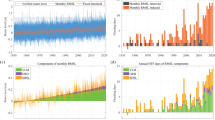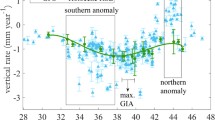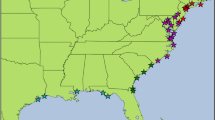Abstract
Sea level rise (SLR) is causing acceleration in the frequency and duration of minor tidal flooding (often called “sunny-day” or “nuisance” flooding) along the U.S. East Coast. Those floods have a seasonal pattern that often follows the monthly mean sea level anomaly which peaks in September–October for stations between New York and south Florida. However, there are large differences between coasts: for example, over 75% of the minor floods occur during the fall in Florida, but during the spring and winter in Boston. Various data and forcing, such as tide gauge records, surface temperatures, winds, long-term tidal cycles, and the Gulf Stream flow, were analyzed to examine potential drivers and mechanisms that can contribute to the seasonal pattern of floods. The seasonal water temperature cycle, with maximum temperatures in August, could not by itself explain the seasonal sea level pattern, but two mechanisms that significantly correlate with the seasonal sea level and flooding patterns are the annual and semi-annual tidal cycles (correlation of ~ 0.97) and changes in the Gulf Stream (GS) flow (correlation of − 0.6; the GS shows a maximum decline in September–October during the period of peak flooding). The combination of the seasonal pattern of tropical storms and high coastal sea level can explain the high frequency of fall flooding along the Southeastern U.S. coasts, while winter storms have more influence on the northeastern coasts. In recent decades however, the seasonal pattern seemed to have shifted so that increased flooding is seen on the northeastern coasts during spring and summer, while in the Mid-Atlantic and southeastern coasts, a dramatic increase in flooding is seen almost exclusively during the fall. A long-term change in the mean zonal wind pattern along the coast can contribute to the recent shift in the seasonal flooding pattern. The study can help regional adaptation and resilience planning for flood-prone coastal cities and communities.















Similar content being viewed by others
References
Baringer MO, Larsen JC (2001) Sixteen years of Florida current transport at 27oN. Geophys Res Lett 28(16):3,179–3,182. https://doi.org/10.1029/2001GL013246
Boon JD (2012) Evidence of sea level acceleration at U.S. and Canadian tide stations, Atlantic coast, North America. J Coast Res 28(6):1437–1445. https://doi.org/10.2112/JCOASTRES-D-12-00102.1
Caesar L, Rahmstorf S, Robinson A, Feulner G, Saba V (2018) Observed fingerprint of a weakening Atlantic Ocean overturning circulation. Nature 556:191–196. https://doi.org/10.1038/s41586-018-0006-5
Cheng Y, Ezer T, Atkinson LP (2017) Analysis of tidal amplitude changes using the EMD method. Continental Shelf Res 148:44–52. https://doi.org/10.1016/j.csr.2017.09.009
Codiga DL (2011) Unified tidal analysis and prediction using the UTide Matlab functions. Technical Report 2011-01. Graduate School of Oceanography, University of Rhode Island, Narragansett, RI. 59pp
Domingues R, Goni G, Baringer M, Volkov D (2018) What caused the accelerated sea level changes along the U.S. East Coast during 2010–2015? Geophys Res Lett 45(24):13,367–13,376. https://doi.org/10.1029/2018GL081183
Ezer T (2013) Sea level rise, spatially uneven and temporally unsteady: why the U.S. East Coast, the global tide gauge record, and the global altimeter data show different trends. Geophys Res Lett 40(20):5439–5444. https://doi.org/10.1002/2013GL057952
Ezer T (2015) Detecting changes in the transport of the Gulf stream and the Atlantic overturning circulation from coastal sea level data: the extreme decline in 2009-2010 and estimated variations for 1935-2012. Glob Planet Chang 129:23–36. https://doi.org/10.1016/j.gloplacha.2015.03.002
Ezer T (2016) Can the Gulf Stream induce coherent short-term fluctuations in sea level along the U.S. East Coast? A modeling study. Ocean Dyn 66(2):207–220. https://doi.org/10.1007/s10236-016-0928-0
Ezer T (2018) On the interaction between a hurricane, the Gulf Stream and coastal sea level. Ocean Dyn 68(10):1259–1272. https://doi.org/10.1007/s10236-018-1193-1
Ezer T (2019a) Numerical modeling of the impact of hurricanes on ocean dynamics: sensitivity of the Gulf Stream response to storm’s track. Ocean Dyn 69(9):1053–1066. https://doi.org/10.1007/s10236-019-01289-9
Ezer T (2019b) Regional differences in sea level rise between the Mid-Atlantic Bight and the South Atlantic Bight: is the Gulf Stream to blame? Earth’s Future 7(7):771–783. https://doi.org/10.1029/2019EF001174
Ezer T, Atkinson LP (2014) Accelerated flooding along the U.S. East Coast: on the impact of sea-level rise, tides, storms, the Gulf stream, and the North Atlantic Oscillations. Earth’s Future 2(8):362–382. https://doi.org/10.1002/2014EF000252
Ezer T, Atkinson LP (2017) On the predictability of high water level along the U.S. East Coast: can the Florida Current measurement be an indicator for flooding caused by remote forcing? Ocean Dyn 67(6):751–766. https://doi.org/10.1007/s10236-017-1057-0
Ezer T, Corlett WB (2012) Is sea level rise accelerating in the Chesapeake Bay? A demonstration of a novel new approach for analyzing sea level data. Geophys Res Lett 39(19). https://doi.org/10.1029/2012GL053435
Ezer T, Atkinson LP, Corlett WB, Blanco JL (2013) Gulf stream’s induced sea level rise and variability along the U.S. mid-Atlantic coast. J Geophy Res 118:685–697. https://doi.org/10.1002/jgrc.20091
Ezer T, Atkinson LP, Tuleya R (2017) Observations and operational model simulations reveal the impact of Hurricane Matthew (2016) on the Gulf Stream and coastal sea level. Dyn Atmos Oceans 80:124–138. https://doi.org/10.1016/j.dynatmoce.2017.10.006
Goddard PB, Yin J, Griffies SM, Zhang S (2015) An extreme event of sea-level rise along the northeast coast of North America in 2009–2010. Nat Commun 6:6345. https://doi.org/10.1038/ncomms7346
Hall T, Booth JF (2017) SynthETC: a statistical model for severe winter storm hazard on Eastern North America. J Clim 30:5329–5343. https://doi.org/10.1175/JCLI-D-16-0711.1
Hayhoe K, Wake CP, Huntington TG, Luo L, Schwartz MD, Sheffield J, Wood E, Anderson B, Bradbury J, DeGaetano A, Troy TJ, Wolfe D (2007) Past and future changes in climate and hydrological indicators in the US Northeast. Clim Dyn 28(4):381–407. https://doi.org/10.1007/s00382-006-0187-8
Hino M, Belanger ST, Field CB, Davies AR, Mach KJ (2019) High-tide flooding disrupts local economic activity. Science Adv 5(2). https://doi.org/10.1126/sciadv.aau2736
John SB III, Yusuf JE (2019) Perspectives of the expert and experienced on challenges to regional adaptation for sea level rise: implications for multisectoral readiness and boundary spanning. Coast Manag 47(2):151–168. https://doi.org/10.1080/08920753.2019.1564951
Kruel S (2016) The impacts of sea-level rise on tidal flooding in Boston, Massachusetts. J Coast Res 32(6):1302–1309. https://doi.org/10.2112/JCOASTRES-D-15-00100.1
Lee SB, Li M, Zhang F (2017) Impact of sea level rise on tidal range in Chesapeake and Delaware bays. J Geophys Res 122(5):3917–3938. https://doi.org/10.1002/2016JC012597
Loftis JD, Forrest D, Katragadda S, Spencer K, Organski T, Nguyen C, Rhee S (2018) StormSense: a new integrated network of IoT water level sensors in the smart cities of Hampton Roads, VA. Mar Technol Soc J 52(2):56–67. https://doi.org/10.4031/MTSJ.52.2.7
Meinen CS, Baringer MO, Garcia RF (2010) Florida current transport variability: an analysis of annual and longer-period signals. Deep Sea Res 57(7):835–846. https://doi.org/10.1016/j.dsr.2010.04.001
Ning L, Bradley RS (2015) Winter climate extremes over the northeastern United States and southeastern Canada and teleconnections with large-scale modes of climate variability. J Clim 28:2475–2493. https://doi.org/10.1175/JCLI-D-13-00750.1
Park J, Sweet W (2015) Accelerated sea level rise and Florida current transport. Ocean Sci 11:607–615. https://doi.org/10.5194/os-11-607-2015
Pawlowicz R, Beardsley B, Lentz S (2002) Classical tidal harmonic analysis including error estimates in MATLAB using T-TIDE. Comput Geosci 28(8):929–937. https://doi.org/10.1016/S0098-3004(02)00013-4
Piecuch CG, Dangendorf S, Ponte R, Marcos M (2016) Annual sea level changes on the North American Northeast Coast: influence of local winds and barotropic motions. J Clim 29:4801–4816. https://doi.org/10.1175/JCLI-D-16-0048.1
Piecuch CG, Dangendorf S, Gawarkiewicz GG, Little CM, Ponte RM, Yang J (2019) How is New England coastal sea level related to the Atlantic meridional overturning circulation at 26°N? Geophys Res Lett 46(10):5351–5360. https://doi.org/10.1029/2019GL083073
Sallenger AH, Doran KS, Howd P (2012) Hotspot of accelerated sea-level rise on the Atlantic coast of North America. Nat Clim Chang 2:884–888. https://doi.org/10.1038/NCILMATE1597
Sweet W, Park J (2014) From the extreme to the mean: acceleration and tipping points of coastal inundation from sea level rise. Earth’s Future 2(12):579–600. https://doi.org/10.1002/2014EF000272
Sweet W, Park J, Marra J, Zervas C, Gill S (2014) Sea level rise and nuisance flood frequency changes around the United States. NOAA Technical report NOS CO-OPS 073, NOAA Silver Spring, MD, 58 pp.
Sweet W, Dusek G, Obeysekera J, Marra JJ (2018) Patterns and projections of high tide flooding along the U.S. coastline using a common impact threshold. NOAA Technical report NOS CO-OPS 086, NOAA Silver Spring, MD, 44 pp.
Todd RE, Asher TG, Heiderich J, Bane JM, Luettich RA (2018) Transient response of the Gulf Stream to multiple hurricanes in 2017. Geophys Res Lett 45. https://doi.org/10.1029/2018GL079180
Valle-Levinson A, Dutton A, Martin JB (2017) Spatial and temporal variability of sea level rise hot spots over the eastern United States. Geophys Res Lett 44:7876–7882. https://doi.org/10.1002/2017GL073926
Wdowinski S, Bray R, Kirtman BP, Wu Z (2016) Increasing flooding hazard in coastal communities due to rising sea level: case study of Miami Beach, Florida. Ocean Coast Manag 126:1–8. https://doi.org/10.1016/j.ocecoaman.2016.03.002
Woodworth PL, Maqueda MM, Gehrels WR, Roussenov VM, Williams RG, Hughes CW (2016) Variations in the difference between mean sea level measured either side of Cape Hatteras and their relation to the North Atlantic Oscillation. Clim Dyn 49(7–8):2451–2469. https://doi.org/10.1007/s00382-016-3464-1
Yusuf JE, John BS III, Covi M, Nicula JG (2018) Engaging stakeholders in planning for sea level rise and resilience. J Contemp Water Res Educ 164(1):112–123. https://doi.org/10.1111/j.1936-704X.2018.03287.x
Acknowledgments
The study is part of ODU’s Climate Change and Sea Level Rise Initiative and the Institute for Coastal Adaptation and Resilience (ICAR; https://oduadaptationandresilience.org/). The Center for Coastal Physical Oceanography (CCPO) provided computational support. The hourly tide gauges sea level data are available from http://opendap.co-ops.nos.noaa.gov/dods/. The Florida Current transport data are available from http://www.aoml.noaa.gov/phod/floridacurrent/. The SST and wind data are available from https://www.esrl.noaa.gov/psd/data/gridded/data.ncep.reanalysis.html.
Author information
Authors and Affiliations
Corresponding author
Additional information
Responsible Editor: Fanghua Xu
This article is part of the Topical Collection on the 11th International Workshop on Modeling the Ocean (IWMO), Wuxi, China, 17–20 June 2019
Rights and permissions
About this article
Cite this article
Ezer, T. Analysis of the changing patterns of seasonal flooding along the U.S. East Coast. Ocean Dynamics 70, 241–255 (2020). https://doi.org/10.1007/s10236-019-01326-7
Received:
Accepted:
Published:
Issue Date:
DOI: https://doi.org/10.1007/s10236-019-01326-7




